Anil K. Jain
White-Box Evaluation of Fingerprint Recognition Systems
Aug 01, 2020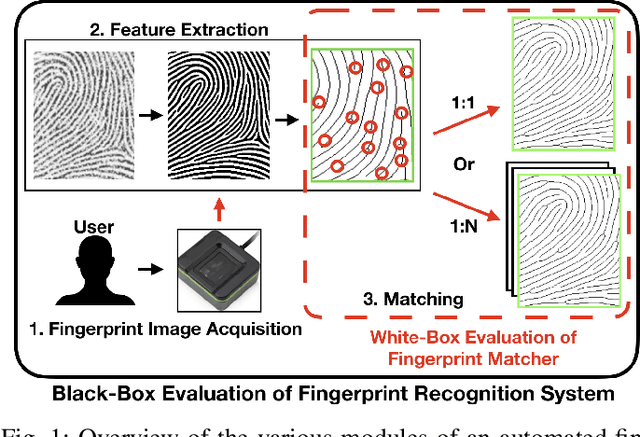
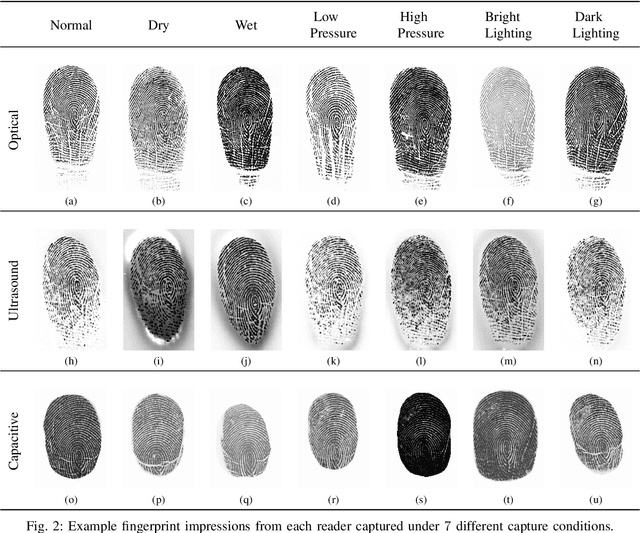
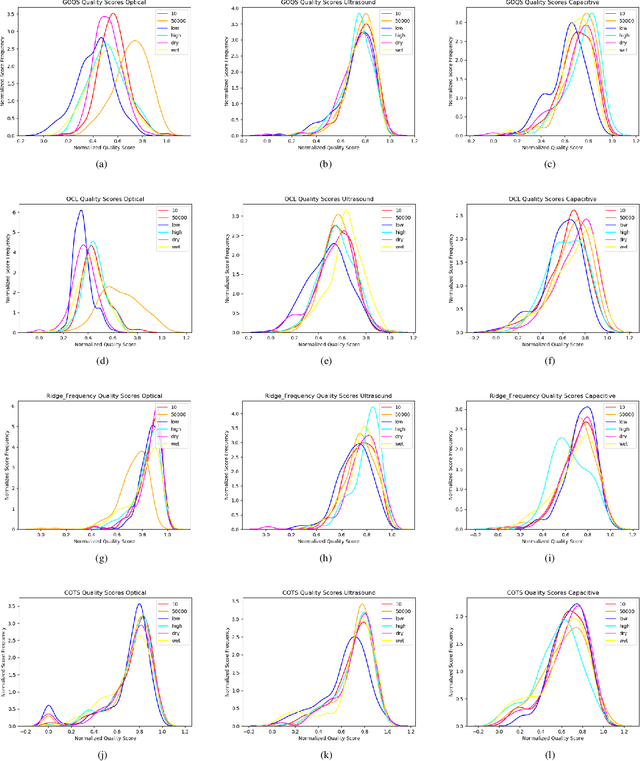
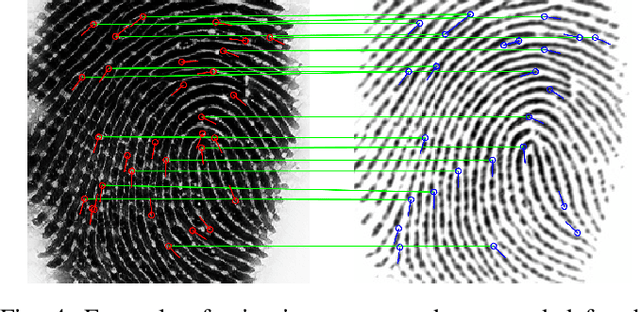
Abstract:Typical evaluations of fingerprint recognition systems consist of end-to-end black-box evaluations, which assess performance in terms of overall identification or authentication accuracy. However, these black-box tests of system performance do not reveal insights into the performance of the individual modules, including image acquisition, feature extraction, and matching. On the other hand, white-box evaluations, the topic of this paper, measure the individual performance of each constituent module in isolation. While a few studies have conducted white-box evaluations of the fingerprint reader, feature extractor, and matching components, no existing study has provided a full system, white-box analysis of the uncertainty introduced at each stage of a fingerprint recognition system. In this work, we extend previous white-box evaluations of fingerprint recognition system components and provide a unified, in-depth analysis of fingerprint recognition system performance based on the aggregated white-box evaluation results. In particular, we analyze the uncertainty introduced at each stage of the fingerprint recognition system due to adverse capture conditions (i.e., varying illumination, moisture, and pressure) at the time of acquisition. Our experiments show that a system that performs better overall, in terms of black-box recognition performance, does not necessarily perform best at each module in the fingerprint recognition system pipeline, which can only be seen with white-box analysis of each sub-module. Findings such as these enable researchers to better focus their efforts in improving fingerprint recognition systems.
Look Locally Infer Globally: A Generalizable Face Anti-Spoofing Approach
Jun 15, 2020
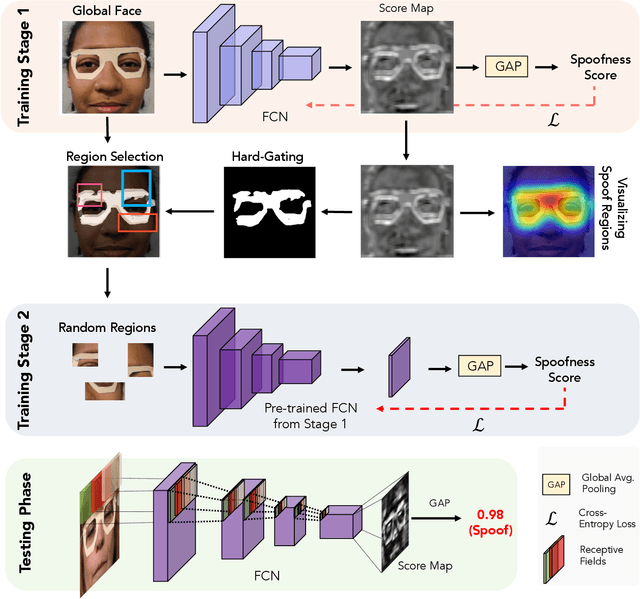


Abstract:State-of-the-art spoof detection methods tend to overfit to the spoof types seen during training and fail to generalize to unknown spoof types. Given that face anti-spoofing is inherently a local task, we propose a face anti-spoofing framework, namely Self-Supervised Regional Fully Convolutional Network (SSR-FCN), that is trained to learn local discriminative cues from a face image in a self-supervised manner. The proposed framework improves generalizability while maintaining the computational efficiency of holistic face anti-spoofing approaches (< 4 ms on a Nvidia GTX 1080Ti GPU). The proposed method is interpretable since it localizes which parts of the face are labeled as spoofs. Experimental results show that SSR-FCN can achieve TDR = 65% @ 2.0% FDR when evaluated on a dataset comprising of 13 different spoof types under unknown attacks while achieving competitive performances under standard benchmark datasets (Oulu-NPU, CASIA-MFSD, and Replay-Attack).
Mitigating Face Recognition Bias via Group Adaptive Classifier
Jun 13, 2020
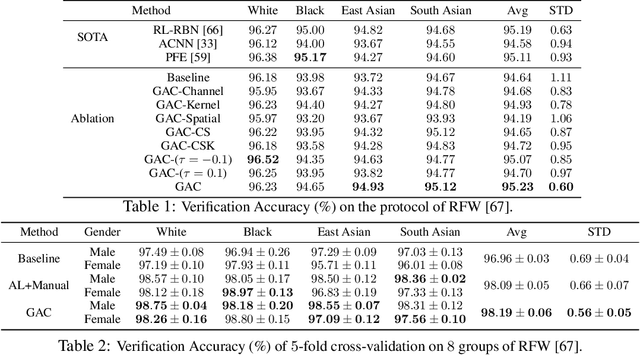
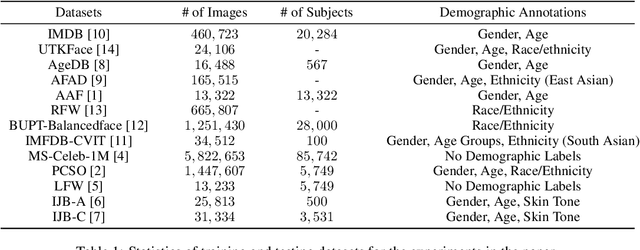
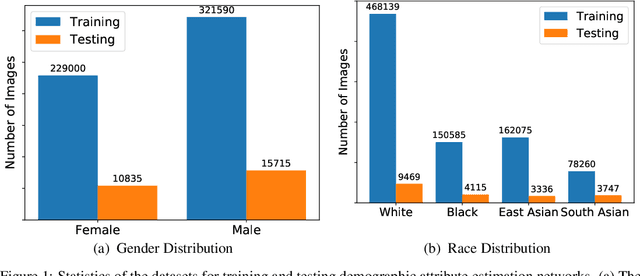
Abstract:Face recognition is known to exhibit bias - subjects in certain demographic group can be better recognized than other groups. This work aims to learn a fair face representation, where faces of every group could be equally well-represented. Our proposed group adaptive classifier, GAC, learns to mitigate bias by using adaptive convolution kernels and attention mechanisms on faces based on their demographic attributes. The adaptive module comprises kernel masks and channel-wise attention maps for each demographic group so as to activate different facial regions for identification, leading to more discriminative features pertinent to their demographics. We also introduce an automated adaptation strategy which determines whether to apply adaptation to a certain layer by iteratively computing the dissimilarity among demographic-adaptive parameters, thereby increasing the efficiency of the adaptation learning. Experiments on benchmark face datasets (RFW, LFW, IJB-A, and IJB-C) show that our framework is able to mitigate face recognition bias on various demographic groups as well as maintain the competitive performance.
DashCam Pay: A System for In-vehicle Payments Using Face and Voice
Apr 08, 2020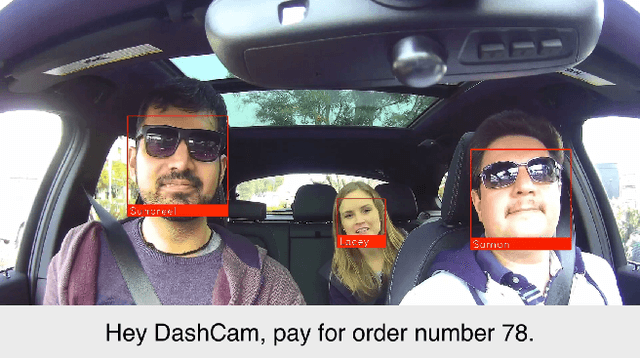
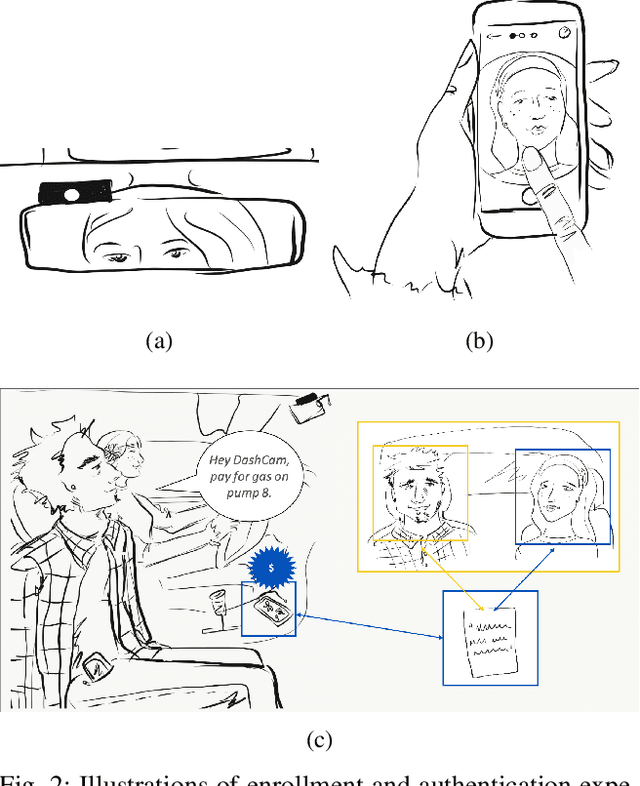
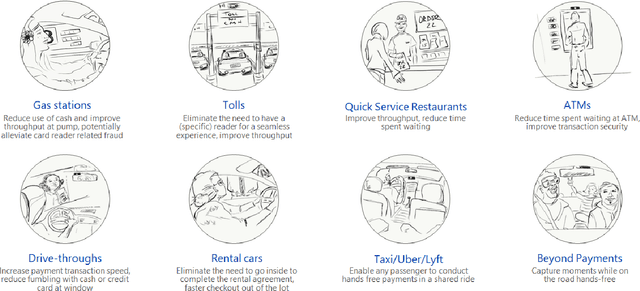
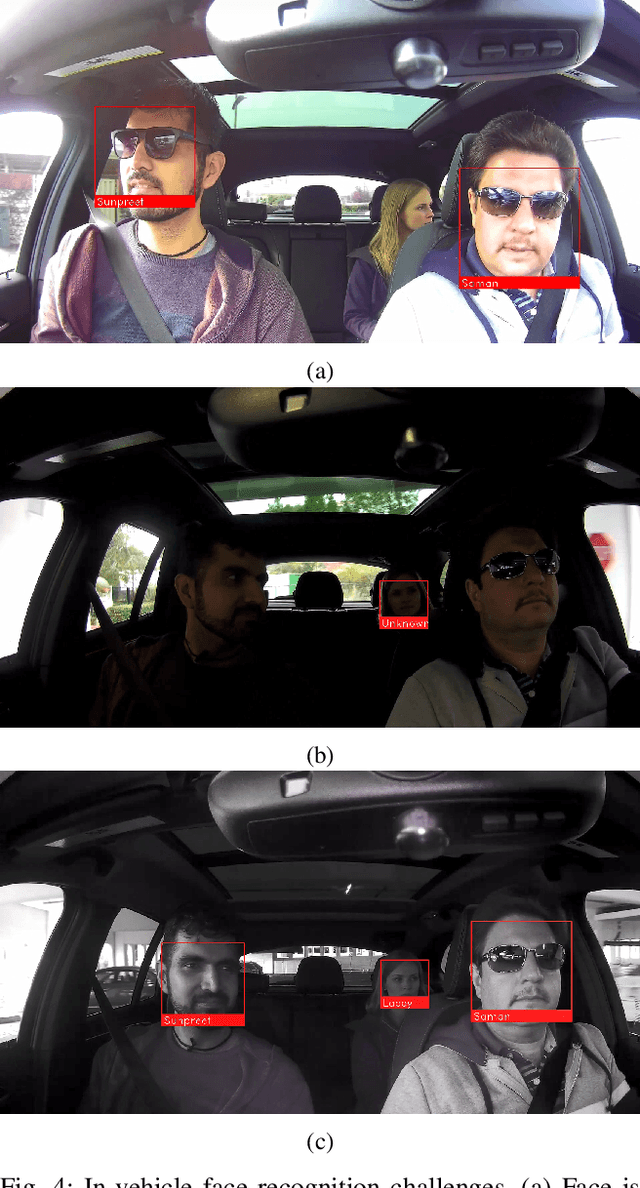
Abstract:We present an open loop system, called DashCam Pay, that enables in-vehicle payments using face and voice biometrics. The system uses a plug-and-play device (dashcam) mounted in the vehicle to capture face images and voice commands of passengers. The dashcam is connected to mobile devices of passengers sitting in the vehicle, and uses privacy-preserving biometric comparison techniques to compare the biometric data captured by the dashcam with the biometric data enrolled on the users' mobile devices to determine the payer. Once the payer is verified, payment is initiated via the mobile device of the payer. For initial feasibility analysis, we collected data from 20 different subjects at two different sites using a commercially available dashcam, and evaluated open-source biometric algorithms on the collected data. Subsequently, we built an android prototype of the proposed system using open-source software packages to demonstrate the utility of the proposed system in facilitating secure in-vehicle payments. DashCam Pay can be integrated either by dashcam or vehicle manufacturers to enable open loop in-vehicle payments. We also discuss the applicability of the system to other payments scenarios, such as in-store payments.
Fingerprint Presentation Attack Detection: A Sensor and Material Agnostic Approach
Apr 06, 2020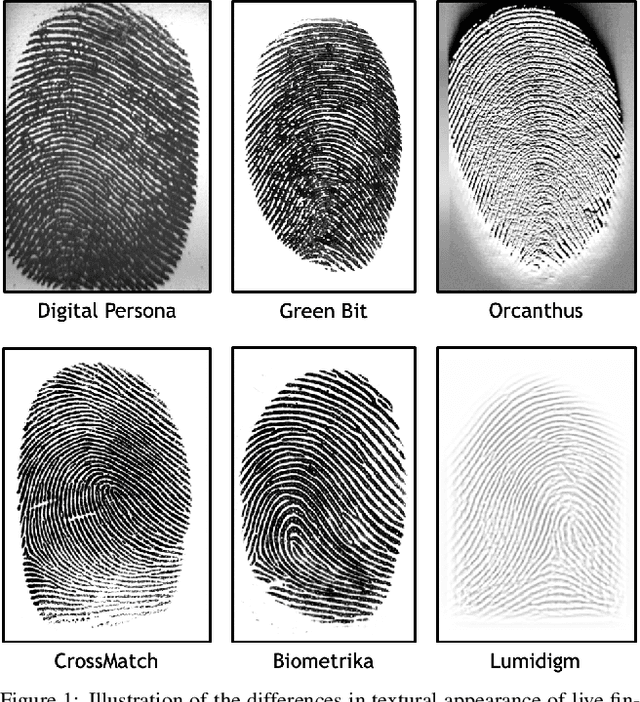
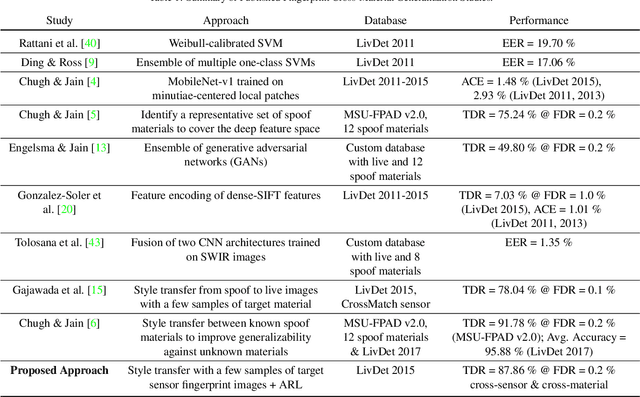
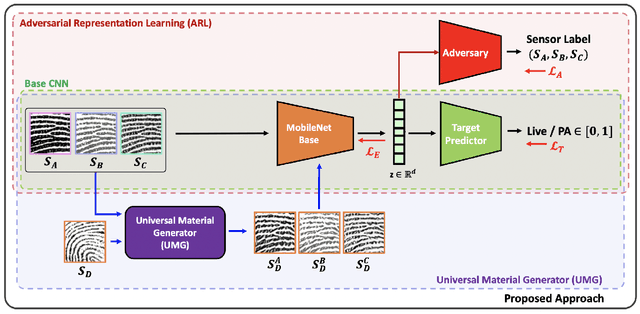

Abstract:The vulnerability of automated fingerprint recognition systems to presentation attacks (PA), i.e., spoof or altered fingers, has been a growing concern, warranting the development of accurate and efficient presentation attack detection (PAD) methods. However, one major limitation of the existing PAD solutions is their poor generalization to new PA materials and fingerprint sensors, not used in training. In this study, we propose a robust PAD solution with improved cross-material and cross-sensor generalization. Specifically, we build on top of any CNN-based architecture trained for fingerprint spoof detection combined with cross-material spoof generalization using a style transfer network wrapper. We also incorporate adversarial representation learning (ARL) in deep neural networks (DNN) to learn sensor and material invariant representations for PAD. Experimental results on LivDet 2015 and 2017 public domain datasets exhibit the effectiveness of the proposed approach.
HERS: Homomorphically Encrypted Representation Search
Mar 27, 2020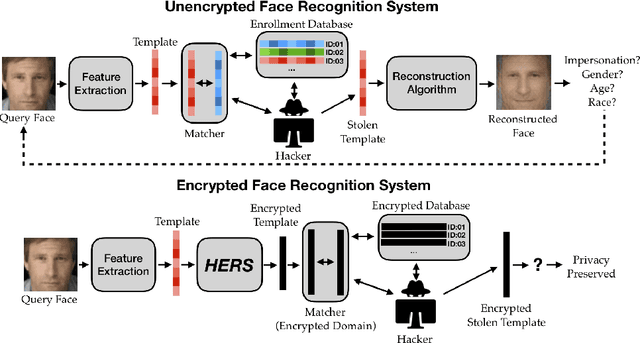



Abstract:We present a method to search for a probe (or query) image representation against a large gallery in the encrypted domain. We require that the probe and gallery images be represented in terms of a fixed-length representation, which is typical for representations obtained from learned networks. Our encryption scheme is agnostic to how the fixed-length representation is obtained and can, therefore, be applied to any fixed-length representation in any application domain. Our method, dubbed HERS (Homomorphically Encrypted Representation Search), operates by (i) compressing the representation towards its estimated intrinsic dimensionality, (ii) encrypting the compressed representation using the proposed fully homomorphic encryption scheme, and (iii) searching against a gallery of encrypted representations directly in the encrypted domain, without decrypting them, and with minimal loss of accuracy. Numerical results on large galleries of face, fingerprint, and object datasets such as ImageNet show that, for the first time, accurate and fast image search within the encrypted domain is feasible at scale (296 seconds; 46x speedup over state-of-the-art for face search against a background of 1 million).
Child Face Age-Progression via Deep Feature Aging
Mar 17, 2020

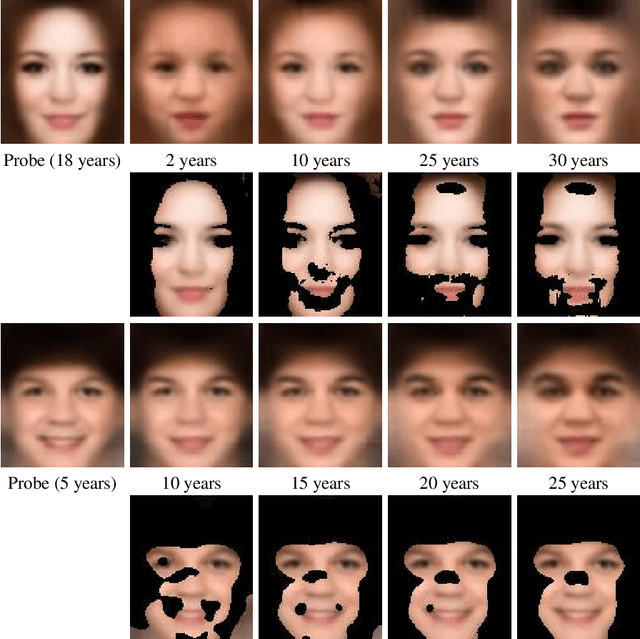
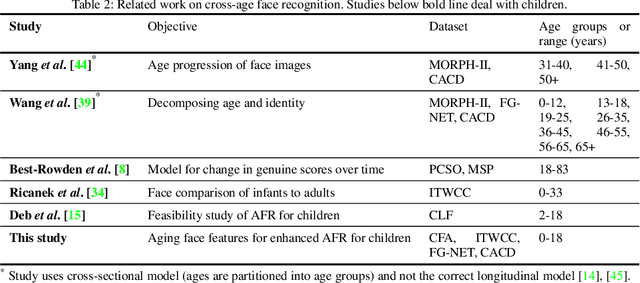
Abstract:Given a gallery of face images of missing children, state-of-the-art face recognition systems fall short in identifying a child (probe) recovered at a later age. We propose a feature aging module that can age-progress deep face features output by a face matcher. In addition, the feature aging module guides age-progression in the image space such that synthesized aged faces can be utilized to enhance longitudinal face recognition performance of any face matcher without requiring any explicit training. For time lapses larger than 10 years (the missing child is found after 10 or more years), the proposed age-progression module improves the closed-set identification accuracy of FaceNet from 16.53% to 21.44% and CosFace from 60.72% to 66.12% on a child celebrity dataset, namely ITWCC. The proposed method also outperforms state-of-the-art approaches with a rank-1 identification rate of 95.91%, compared to 94.91%, on a public aging dataset, FG-NET, and 99.58%, compared to 99.50%, on CACD-VS. These results suggest that aging face features enhances the ability to identify young children who are possible victims of child trafficking or abduction.
Generalizing Face Representation with Unlabeled Data
Mar 17, 2020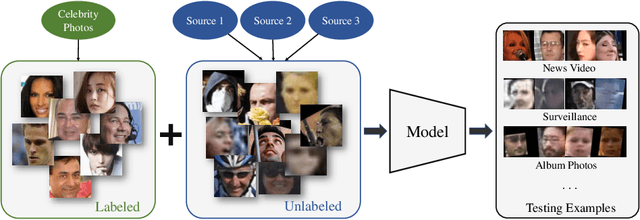

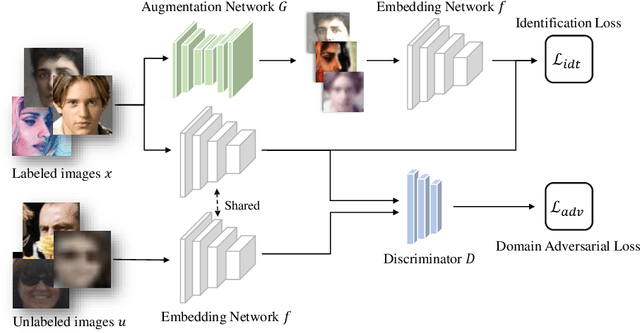
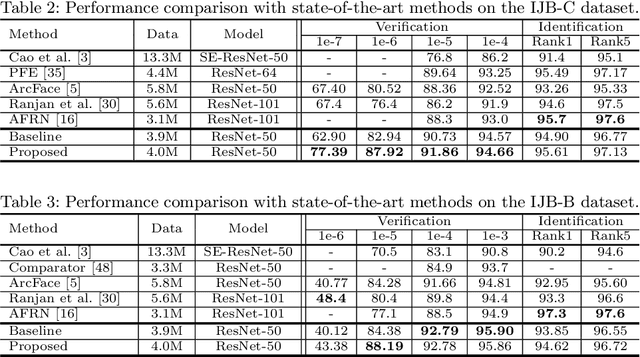
Abstract:In recent years, significant progress has been made in face recognition due to the availability of large-scale labeled face datasets. However, since the faces in these datasets usually contain limited degree and types of variation, the models trained on them generalize poorly to more realistic unconstrained face datasets. While collecting labeled faces with larger variations could be helpful, it is practically infeasible due to privacy and labor cost. In comparison, it is easier to acquire a large number of unlabeled faces from different domains which would better represent the testing scenarios in real-world problems. We present an approach to use such unlabeled faces to learn generalizable face representations, which can be viewed as an unsupervised domain generalization framework. Experimental results on unconstrained datasets show that a small amount of unlabeled data with sufficient diversity can (i) lead to an appreciable gain in recognition performance and (ii) outperform the supervised baseline when combined with less than half of the labeled data. Compared with the state-of-the-art face recognition methods, our method further improves their performance on challenging benchmarks, such as IJB-B, IJB-C and IJB-S.
Towards Universal Representation Learning for Deep Face Recognition
Feb 26, 2020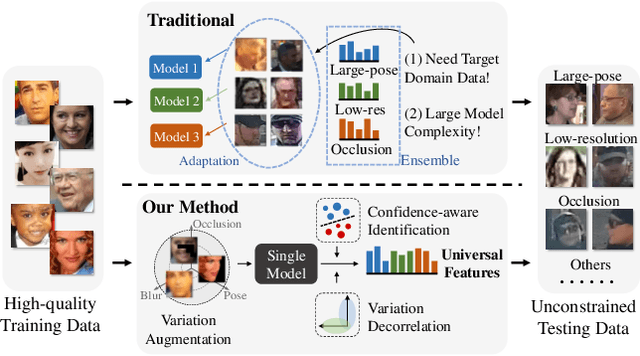

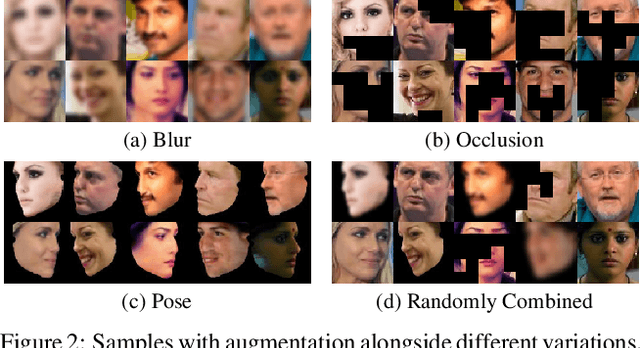
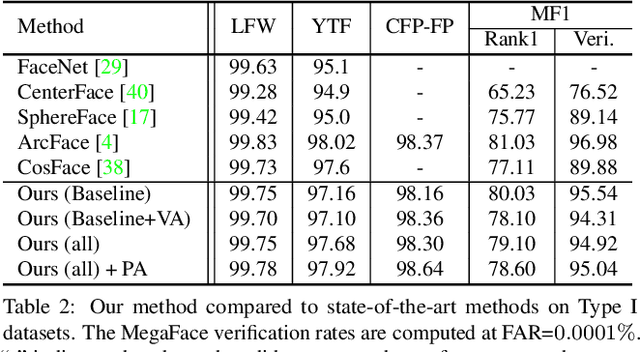
Abstract:Recognizing wild faces is extremely hard as they appear with all kinds of variations. Traditional methods either train with specifically annotated variation data from target domains, or by introducing unlabeled target variation data to adapt from the training data. Instead, we propose a universal representation learning framework that can deal with larger variation unseen in the given training data without leveraging target domain knowledge. We firstly synthesize training data alongside some semantically meaningful variations, such as low resolution, occlusion and head pose. However, directly feeding the augmented data for training will not converge well as the newly introduced samples are mostly hard examples. We propose to split the feature embedding into multiple sub-embeddings, and associate different confidence values for each sub-embedding to smooth the training procedure. The sub-embeddings are further decorrelated by regularizing variation classification loss and variation adversarial loss on different partitions of them. Experiments show that our method achieves top performance on general face recognition datasets such as LFW and MegaFace, while significantly better on extreme benchmarks such as TinyFace and IJB-S.
Fingerprint Spoof Detection: Temporal Analysis of Image Sequence
Dec 17, 2019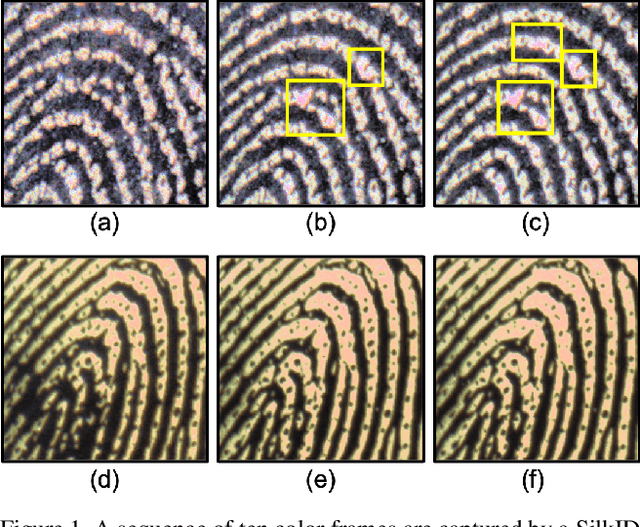

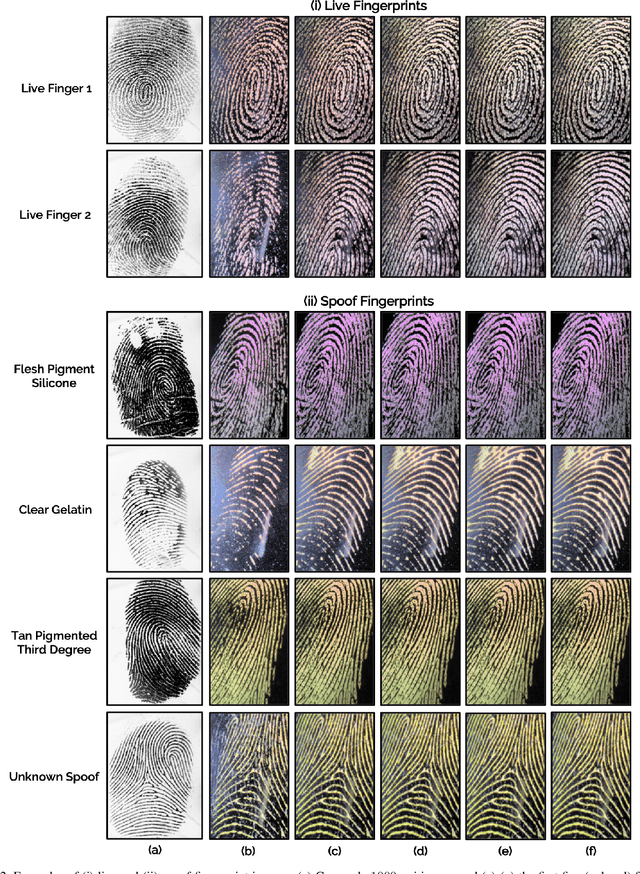
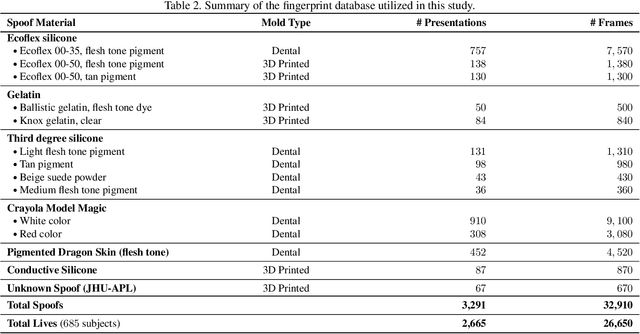
Abstract:We utilize the dynamics involved in the imaging of a fingerprint on a touch-based fingerprint reader, such as perspiration, changes in skin color (blanching), and skin distortion, to differentiate real fingers from spoof (fake) fingers. Specifically, we utilize a deep learning-based architecture (CNN-LSTM) trained end-to-end using sequences of minutiae-centered local patches extracted from ten color frames captured on a COTS fingerprint reader. A time-distributed CNN (MobileNet-v1) extracts spatial features from each local patch, while a bi-directional LSTM layer learns the temporal relationship between the patches in the sequence. Experimental results on a database of 26,650 live frames from 685 subjects (1,333 unique fingers), and 32,910 spoof frames of 7 spoof materials (with 14 variants) shows the superiority of the proposed approach in both known-material and cross-material (generalization) scenarios. For instance, the proposed approach improves the state-of-the-art cross-material performance from TDR of 81.65% to 86.20% @ FDR = 0.2%.
 Add to Chrome
Add to Chrome Add to Firefox
Add to Firefox Add to Edge
Add to Edge